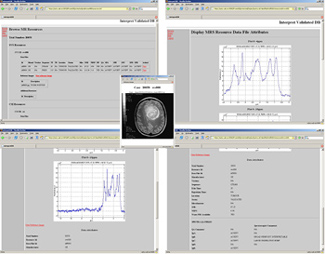A spectroscopy translator available on Internet

Magnetic resonance spectroscopy (MRS) is a technique which is frequently used in medical centres which have magnetic resonance equipment. MRS allows us to detect, in a non-invasive manner, some products of cellular metabolism which are to be found in virus organisms. MRS allows us to obtain certain kinds of biochemical characterization, for example, of tumour tissue, without the need to carry out a biopsy. However, MRS poses two problems in terms of its clinical application.
Difficulty in interpreting the patterns of MRS due mainly to:
1. The need for biochemical knowledge, while MRS data is obtained by radiological services, by radiologists who are basically trained to recognise anatomical structures.
2. The way that data is stored in clinical centres, normally on optical discs or on radiographic plates.
The European project INTERPRET, coordinated by professor Carles Arús from the UAB, worked to solve these two problems in the practical application of the diagnosis of brain tumours. The first result of the project was a decision-making support system, which aided professionals in the radiological field to interpret MRS data. The second result is a multi centre MRS database, accessible on the Internet and with all entries validated by a multidisciplinary committee of experts in oncology, neuroradiology and biomedical spectroscopy.
The database contains MRSs, clinical data and resonance images of 304 patients. All the patients or their family members gave their consent to participate in the study and, moreover, the data are totally anonymous, so it is impossible to recognise any personal data whatsoever.
At a computer science level, the data is protected by SSL and the information is transferred in encrypted form. To access the data, a password is required which is only distributed to those clinical centres which have requested it, after signing a confidentiality agreement, committing the centre not to redistribute the data or use it for commercial medical reasons. The database was developed in technical terms by two scientists from the University of Sussex (UK), one of whom was transferred to the UAB to complete the database.
The data contained comes from Spain, France the UK, Argentina, Holland and Poland, and the inputting of the data was coordinated from the UAB. At present the UAB maintains the database.
The importance of having such a database of MRSs of brain tumours available lies in the fact that there are around one hundred different varieties of tumours, which are distributed in large families depending on their tissue origin. Some tumours have a characteristic MRS pattern, which allows for the characterization of the family to which they belong without the need to carry out a brain biopsy.
Additionally there are very rare tumours, such as for example hemangiopericitomes (0.4% of all brain tumours). The existence of a database such as that found at the UAB, allows rare cases which come to light over time in all the European countries which are participating in the project to be centralized in one place. This way, we can develop better decision-making systems based on MRS patterns for these infrequent types.
Currently the group headed by professor Arús participates in two European projects: eTUMOUR and HealthAgents. We hope that, in the long term, through these projects, the number of MRS spectra will increase notably and therefore the support tools for decision-making may be extended to more families of brain tumours.


